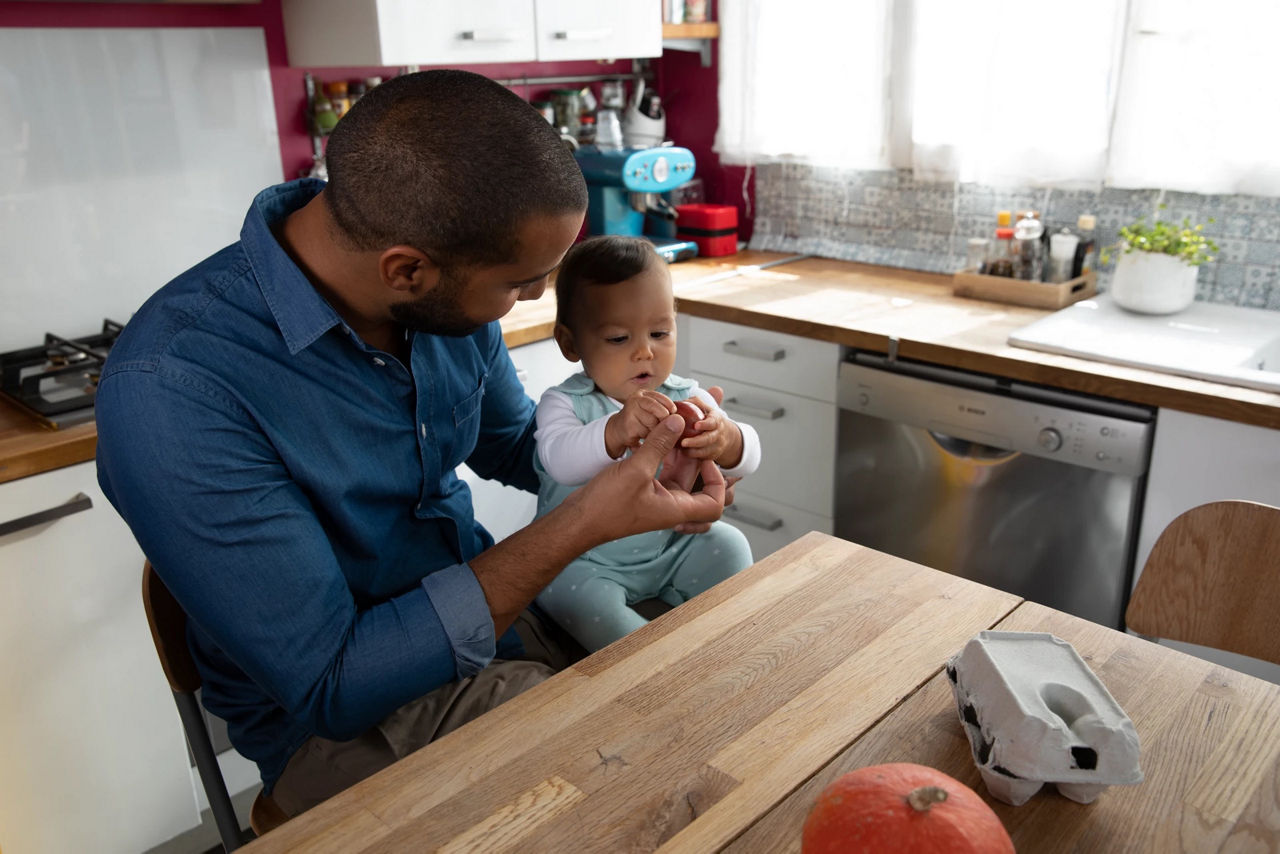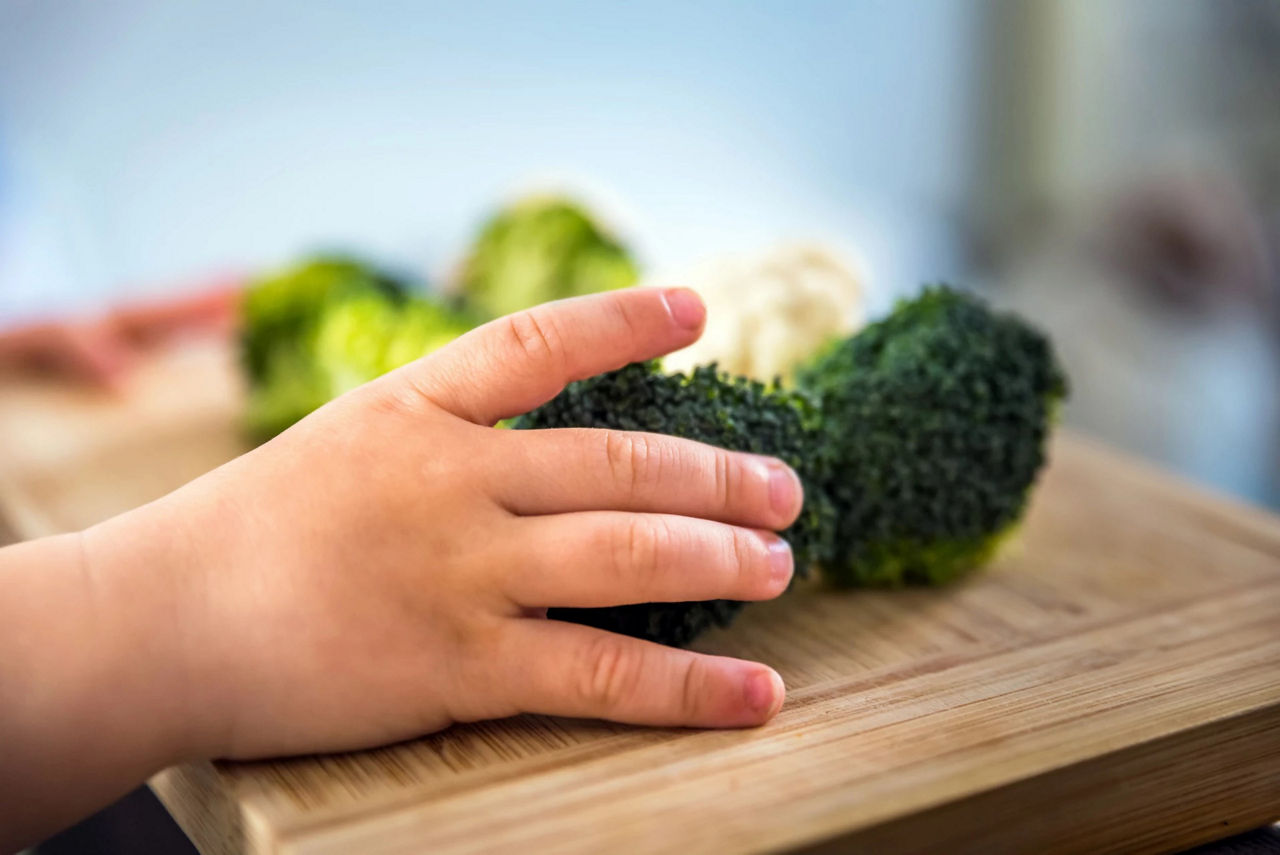The Complete Weaning Guide – How to Start your Weaning Journey
Get ready for the wonderful world of baby weaning.

From first spoonfuls to fabulous finger foods, here you’ll find lots of advice and guidance on when and how to start weaning, as well as plenty of delicious baby weaning ideas to use along the way.
If you’re ready to get going, watch our short video all about how to wean your baby.
When to Start Weaning
While you’ll probably hear different opinions about when to start weaning your baby, guidance from the World Health Organization states that you should wait until your little one is at least 6 months old1.
Until this point, your baby will get all the energy and nutrients they need from breast milk or first infant formula if they are formula feeding. In addition, they’ll2:
- Be able to manage and digest solid foods.
- Have more developed hand-eye-mouth coordination skills.
- Be able to chew and swallow food more effectively.
If your baby arrived early (before 37 weeks of pregnancy), speak to your GP or healthcare professional about when to start weaning.
Signs of weaning: is your baby hungry for more?
As a general rule of thumb, if your baby is 6 months old and can3:
- Sit up and keep their head steady
- Look at food, pick it up and put it in their mouth all by themselves
- Swallow food
Then, it’s very likely that they’re ready for solid food.
Ready or not?
It’s sometimes easy to mistake some of the typical baby feeding cues and behaviours for signs that your little one is ready to wean. For example; chewing their fists, waking at night, and wanting more milk feeds than usual3.
Whilst it can be tempting to start weaning your baby before they’re ready, giving your little one solid foods doesn’t mean they’ll stop waking during the night. It may be that a little extra milk is all that they need for now2.
Your baby weaning checklist
Get weaning ready with our handy list of things to help you get started:
- A blender. Whilst this isn’t a necessity, it can help to save time if you’re planning to start weaning your baby with purees.
- Plastic containers - to help you prep and freeze your baby’s meals ahead of time. “Ice cube trays were a real help”, says Eva’s mum. “They meant I could batch cook a selection of different purees for my daughter without losing too much space in the freezer - bonus!”
- High chair - to keep them upright as they eat. Follow this top tip from Seb’s mum: “Put a plastic tablecloth or something similar under your baby’s high chair. Trust me when I say that it will help to provide your floor with some much-needed protection from the food your baby drops - or chooses to launch!”
- Small plastic (or other non-breakable) bowls. You can even buy bowls with suction cups to prevent them from ending up on the floor.
- Baby weaning spoons. Make sure they’re soft and gentle on your little one’s gums.
- Bibs. Things are about to get messy! Plastic or pelican bibs are easier to clean and will help protect your baby’s clothes.
- A first cup - to encourage your baby to take small sips of water.
Want more feeding advice from our parents and baby experts?
 Try to include lots of different types of vegetables, fruits and grains into their meals, as part of a varied and balanced weaning diet.
Try to include lots of different types of vegetables, fruits and grains into their meals, as part of a varied and balanced weaning diet.
Safety and hygiene
To keep your baby safe and sound, take a look at our advice around food prep hygiene and safety2:
- Never leave your baby alone - you should always be with them to minimise the risk of choking.
- Test the temperature of your baby’s food to make sure it’s ready for them to eat.
- Avoid hard foods like whole nuts or chunks of raw carrot and apple. In addition, always remove any hard stones, pips or bones from your baby’s food.
- Grapes, cherry tomatoes or any other small round foods should be cut into smaller pieces and not given whole.
- Thoroughly wash your hands, surfaces and any equipment you intend to use before making your little one’s meals.
- When using fresh fruit and vegetables, always ensure they’re thoroughly washed and peeled.
Introducing solid foods
When you first start to wean your baby, it’s all about getting them used to the idea of eating solid food rather than how much they’re eating. Your baby may not swallow much at first and push food out of their mouth with their tongue, but that’s OK. For now, breast milk or first infant formula if they are formula feeding will be your baby’s main source of energy and nutrients2.
Offer your baby a few spoonfuls of food once or twice each day. Go at their own pace, and they’ll soon start eating more from a spoon or with their fingers. As your baby gets into the swing of things, you can start increasing their portions and offering a wider variety of tastes and textures2.
“I remember feeling concerned that my baby wasn’t getting enough food”, says Logan’s mum. “But I soon realised that I didn’t have to worry. After a while, he just got the hang of it, and in the blink of an eye, he was eating all sorts of different foods.”
First Textures
Purees can be a great introduction to solid food for weaning babies. Why not try offering baby rice or porridge made with their usual milk? Mix this with fruit or vegetable purees to offer additional flavour and texture.
Some easy-to-cook and blend fruits and vegetables include:
- Parsnips
- Sweet potato
- Cauliflower
- Carrots
- Apples
- Pears
As your baby gets used to eating and swallowing purees, move on to mashed and lumpy foods to help your baby’s weaning progress. For example, try mashing avocado or cooked peaches - both nutritious and yummy options.
Discover our handy guide to making baby food.
Baby-led weaning
Instead of feeding them purees or mashed food with a spoon, baby-led weaning allows your baby to feed themselves right from the start with various finger foods4. Soft-cooked carrot sticks or broccoli florets are very often firm favourites.
There’s no right or wrong here, so choose the weaning approach that works for you and your baby - that might even be a blend of the two.
First Tastes
When you start weaning, offer your weaning baby a variety of foods with a variety of different tastes. Introducing your baby to non-sweet tastes sooner rather than later is a good idea so they don’t develop a preference - or a sweet tooth!
At first, keep it simple with single vegetables and fruits. After a while, you can experiment with mixing flavours and create more interesting dishes for your little one as they settle into weaning.
Tasty and nutritious options include:
| Vegetables | Fruits |
|
|
Foods to Avoid
There are some foods to avoid as you get your baby used to a healthy and balanced diet.
Avoid cooking with salt or adding it to your baby’s food as it isn’t good for their kidneys. Weaning babies shouldn’t be offered things like5:
- Bacon and sausages
- Salty crackers
- Chips with salt
- Crisps
- Ready meals and takeaways
- Stock cubes and gravy
Other foods to avoid when weaning your baby include5:
- Sugar - your baby doesn’t need it.
- Biscuits, cakes and any other foods that are high in saturated fat.
- Honey. As well as being a sugar, honey can sometimes cause botulism, a rare but life-threatening condition caused by toxins produced by bacteria6. As such, your baby shouldn’t eat honey until they’re at least a year old.
- Some types of cheese. Avoid mould-ripened, soft-vein blue or ripened goats’ milk cheese. This is because they can carry a bacteria that cause listeria.
- Rice drinks. These shouldn’t be used as a substitute for breast milk or formula milk for children under the age of 5, as they can contain too much arsenic7.
Learn more about the foods to avoid when weaning.
Transitioning to Cow’s Milk
Your baby won’t be ready for cows’ milk to be their main drink until they reach 1 year, and you should continue to offer their usual milk feeds alongside solid foods.
However, when they reach 6 months, it’s OK to cook with and mix cows’ milk in your baby’s food8.
Managing Weaning Challenges
Whilst some babies can’t get enough from their first spoonful, others find adjusting to the new tastes and textures a little trickier. If you find yourself dealing with one or two weaning challenges, here are a few top tips to help:
- Go at your baby’s pace. “I had this idea in my head that I’d have my baby’s mealtimes done and dusted in no time”, says Sylvie’s mum. “The reality was very different. If I could offer one piece of advice, it would be to pick a time when you’re not in a hurry so that you and your baby have plenty of time to enjoy weaning without the stress.”
- Offer solid foods before a milk feed so your baby isn’t full.
- Your baby is always learning from you - this includes at mealtimes. Eating together, whether just the two of you or as a family, will help your baby adapt.
- Turning off the television and putting any toys away will help your baby focus on learning a brand new skill - eating and enjoying new foods!
- Don’t force your baby to eat. If they refuse the food you give them after you’ve tried a few times, simply take it away and try again at the next meal.
- Stick with it! Your baby might need to try something 10 or more times before they’ll accept a new food. Just keep going and continue to offer your baby a wide variety of foods2.
Monitoring your baby’s weaning progress
If you’ve got any concerns about how much your baby is eating, or you’re keen to track how they’re getting on, why not keep a weaning diary? That way, you can document all the new foods your baby tries and how they respond.
Take a look at our handy weaning guide below to help you get started9:
| 6 months | Offer your baby pureed fruits, vegetables or plain yoghurt from a spoon or softly cooked finger food. Offer small amounts a couple of times a day. Within a couple of weeks, they may well have moved on to different flavours and textures, such as mashed or minced fish and meat. |
7-9 months | By now, your baby is starting to enjoy a more varied and balanced diet and gradually moving towards 3 meals a day in addition to their usual milk feeds. This might consist of mashed and lumpy foods with a combination of flavours and finger foods such as toast and hard-boiled eggs. At this point, you may notice that their milk feeds are starting to decrease. If you’re breastfeeding, you can continue to feed your baby on demand. If you’re formula feeding, aim to give your baby around 500-600ml of formula milk each day. |
| 10-12 months | As they approach their first birthday, your baby is well on their way to being a weaning pro. As well as three meals a day, you can offer your baby an additional healthy snack. |
Related articles

Need some help?
You can get quick answers to common questions in our FAQs.
Alternatively, if you need help with general pregnancy or baby advice, or maybe on using or ordering our products - our expert team are always on hand to talk about feeding your baby.
- WHO. Complimentary feeding [online]. Available at https://www.who.int/health-topics/complementary-feeding#tab=tab_1. [Accessed February 2025]
- NHS. Your baby's first solid foods [online 2022]. Available at https://www.nhs.uk/conditions/baby/weaning-and-feeding/babys-first-solid-foods/. [Accessed February 2025]
- HSE. Starting your baby on solid foods [online 2022]. Available at https://www2.hse.ie/babies-children/weaning-eating/weaning/solid-foods/. [Accessed February 2025]
- NHS Just One Norfolk. What is baby-led weaning? [Online]. Available at https://www.justonenorfolk.nhs.uk/healthy-lifestyles/infant-feeding/weaning-moving-on/what-is-baby-led-weaning/. [Accessed March 2025]
- NHS. Foods to avoid giving babies and young children [online 2022]. Available at https://www.nhs.uk/conditions/baby/weaning-and-feeding/foods-to-avoid-giving-babies-and-young-children/. [Accessed February 2025]
- NHS. Botulism [online 2022]. Available at https://www.nhs.uk/conditions/botulism/. [Accessed March 2025]
- NHS. Drinks and cups for babies and young children [online 2022]. Available at https://www.nhs.uk/conditions/baby/weaning-and-feeding/drinks-and-cups-for-babies-and-young-children/. [Accessed March 2025]
- HSC Public Health Agency. Weaning made easy moving from milk to family meals [online]. Available at https://www.publichealth.hscni.net/sites/default/files/2019-03/Weaning_made_easy_nov%202018_0.pdf. [Accessed February 2025]
- HSC Public Health Agency. Weaning made easy moving from milk to family meals [online]. Available at https://www.publichealth.hscni.net/sites/default/files/2019-03/Weaning_made_easy_nov%202018_0.pdf. [Accessed February 2025]
Last reviewed: April 2025
Reviewed by Nutricia’s Medical and Scientific Affairs Team




